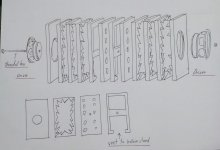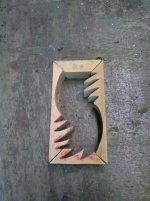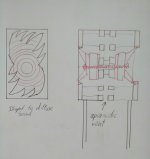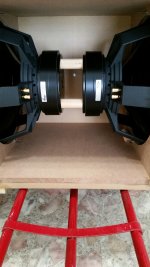Box-speaker damping (Qtc)
Box-speaker damping (Qtc)
Qtc = 0.5 : Perfect transients, but low efficiency (over damped).
Qtc = 0.707 : This is the number most people try to reach for, as it gives good transients and flat response with minimum cutoff.
0.7 < Qtc < 1.2 : Better efficiency, somewhat degraded transients, steeper roll off.
Qtc > 1.2 : High efficiency, bad transients, bad frequency response (under damped).
Sealed enclosure explained in detail and calculator | Audio Judgement
Box-speaker damping (Qtc)
Qtc = 0.5 : Perfect transients, but low efficiency (over damped).
Qtc = 0.707 : This is the number most people try to reach for, as it gives good transients and flat response with minimum cutoff.
0.7 < Qtc < 1.2 : Better efficiency, somewhat degraded transients, steeper roll off.
Qtc > 1.2 : High efficiency, bad transients, bad frequency response (under damped).
Sealed enclosure explained in detail and calculator | Audio Judgement
Qtc=. 500 thru 0.577
Why, OH WHY (in the world) would we still target a low Q woofer system ?
Simple answer: Because of the room.
4 Pi steradians (corner placement0 = +9db
Look it up. But, in a nutshell, what we design for in a speaker rarely ends up being that way in the real world. This is why I laugh, when I see so many of y'all obsessed with doing design simulations.
The elephant ion the room isn't the the elephant, it's the room.
Why, OH WHY (in the world) would we still target a low Q woofer system ?
Simple answer: Because of the room.
4 Pi steradians (corner placement0 = +9db
Look it up. But, in a nutshell, what we design for in a speaker rarely ends up being that way in the real world. This is why I laugh, when I see so many of y'all obsessed with doing design simulations.
The elephant ion the room isn't the the elephant, it's the room.
It is not even the corner placement that is the issue with low frequencies. The gain from boundaries extends to lowmid frequencies, depending on the geometry of the total. Modal behavior of the sound field is dominant. And typical room modes have high Q's, 10 is no exception. In this perspective discussions about Qtc 0.7 or 0.6 are moot really.
Qtc = 0.5 : Perfect transients, but low efficiency (over damped).
There we are 🙂 It would help if the varying definitions were dropped and people just referred to the Qtc.
When I was describing the math or engineering terms of over damped, under damped or critically damped; I was referring to mechanical or moving systems in general. I wasn't specifically addressing the actual Q (figure of merit?) of a speaker and box. The idea again is to not have the box or driver alter the original incoming signal in any way. If the cone stops moving too soon or keeps moving after the signal is gone; this is not what we want. Box style and size determine this but also the treatments such as wall dampening, stuffing and other absorbing or diffusing "tricks". I tend to use the terms too tight or too loose; like my example of a car suspension.
Yes, the room has a GREAT effect (affect?) for sure. The reason auditoriums are shaped the way the are is for very good reason. There are very little or NO parallel surfaces. "Bass traps" and wall treatments can help with some listening room modes. Have you ever experienced a speaker playing in a larger rectangular room? You can walk around and have peaks and nulls depending on where you are within the room. This is why in my case; I do final tweaking and tuning in the actual room the system is to be used in. Moving a speaker box just a few inches sometimes can make a huge difference. In my current "house"; space is limited and room placement of the speakers is less than ideal but I am trying to make the most of it. All of my drivers are in their own enclosure; this gives me more flexibility. I keep the baffle size at the bare minimum; I am not concerned about baffle gain since each driver pair also has a different amplifier with adjustable gain.
A low Q alignment also takes fuller advantage of cabin gain.
It is indeed a better match
Agree; it is sometimes very difficult to get rid of "boominess" or excessive bass in the room. A more refined (shallow or less offensive or obtrusive) bass is preferable to too much in my opinion.
Well, a band pass filter and/or a resonating system like an electrodynamic driver always transforms the signal. That is the bare essence of a band filter function. And really, any Q between 0.5 and 1 is okay for domestic appliances.The idea again is to not have the box or driver alter the original incoming signal in any way. If the cone stops moving too soon or keeps moving after the signal is gone; this is not what we want.
Acoustic treatments sure do help. But controlling room modes or 'eigentonen' requires measures most of us do not want to accept. E.g. big corner traps are reasonably effective, but they don't get the Q of a modal resonance from 10 to 1. Let alone speaker placement, it only redistributes the presence of the resonances. So in effect you are listening to a varying set of resonances of your room with Q's far higher than one, with the time domain effects as a side dish. Luckily our ears aren't that sensitive to these nonlinear effects and are adapting quickly most of the time. But the resonances with high Q's stay around, don't fool yourself in that respect.Box style and size determine this but also the treatments such as wall dampening, stuffing and other absorbing or diffusing "tricks". I tend to use the terms too tight or too loose; like my example of a car suspension.
[EDIT]I should add multiple subs are up til now the most economic solution when treating room modes. But the experienced here would know that.
Last edited:
Agree; there are very real world limits to what we can do or control. I have said if I were to ever become rich and famous (ha...a joke here) I would design my listening room like a small auditorium.
Thank for clearing that up, it just sounded to me from the terminology and example that you were referring to damping of a resonance.
 There are TWO causes of boxy sound, one is the sound coming from the back of the driver bouncing around the cabinet and either coming out through the driver, or through the cabinet walls. The second is the vibration of the driver shaking the cabinet, just like a violin strings vibrate it's wooden body, I have attached a diagram of my " ply woods " that use two identical drivers mounted back to back to cancel out the second, and a VERY solid enclosure to stop sound leaking through. To increase the effective volume, they have a vent in the bottom to connect with the hollow stand. There is a capacitor across the rear driver to bias the highs to the front. If you want to go the whole hog at reducing the boxy sound you'd probably be best going the Eclipse td way. The BBC ls3/5a has a very lossy cabinet, you could copy the screwed on back version.
There are TWO causes of boxy sound, one is the sound coming from the back of the driver bouncing around the cabinet and either coming out through the driver, or through the cabinet walls. The second is the vibration of the driver shaking the cabinet, just like a violin strings vibrate it's wooden body, I have attached a diagram of my " ply woods " that use two identical drivers mounted back to back to cancel out the second, and a VERY solid enclosure to stop sound leaking through. To increase the effective volume, they have a vent in the bottom to connect with the hollow stand. There is a capacitor across the rear driver to bias the highs to the front. If you want to go the whole hog at reducing the boxy sound you'd probably be best going the Eclipse td way. The BBC ls3/5a has a very lossy cabinet, you could copy the screwed on back version.An interesting belt and braces approach to cabinet vibration! I'm not sure it addresses potential reflections back through the cone as well though. Presumably the rear woofer needs some space away from any walls to breath, but with its low pass filter it's a neat answer to baffle step correction. A series inductor would be preferable instead I think, to keep the amplifier load reasonable?
This reminds me of aspects of some of Quad''s designs where a single idea serves dual purposes. In this case an extra rear firing woofer combines vibration control with BSC and the stand doubles as enclosure volume.
Last edited:


Both the rear and front are vented to the stand, the cap across the rear is only about 3.5uf, the impedance of the driver will have risen by the time is has an effect, as the drivers ( 4 ohms ) are in series I'll guess the speaker will be close to an 8 ohm load up to 20,000 Hz . The " walls " are shaped to give points to the sound wave from the driver, hopefully diffusing it. 4" car speakers aren't the best full range drivers, but if they're coaxial they'll have a hole through the magnet ( for the tweeter ) so you can stick a threaded bar through to clamp the whole thing together ( or the driver to a lump of iron ). I think an open baffle " tweeter " on the top would perhaps improve it.
Nice. How about a wooden divider between them ( with the magnets butted up against ) to stiffen the sides. I did something similar with two phoenix gold 10" subs, but used threaded bar through the driver mounting holes from one side to the other, I'm considering ( if I ever get around to it ) to stick in two dividers to make it aperiodically loaded. PS. reducing boxeness has been my obsession for 15 years.
A similar method used for a bass section.
This stops the whole speaker jumping around but creates a noisy cabinet due to both drivers hammering away on it.
I looked at running long bolts with spacers between the two drivers mounting holes. This stopped the drivers hammering on the cabinet but the frame of the driver was still driven and it pinched a significant amount of volume. When I simulated the vibration of the cabinet the long slender spacers were resonating within the passband. Perhaps it could have been made to work but it is not elegant.
The right way to do it (if practical) is to rigidly mount the drivers back to back perhaps with a short possibly vented cylinder between the magnets of the two drivers if it cannot be done directly. This keeps vibration out of the cabinet and the frame of the drivers while providing at worst a short stiff structure between the two driven magnets.
Try Babybel cheese wax ( the red stuff ) between the magnets and the spacer. I have used some beside the magnet and basket ( the steel basket was flexing ) and it damped the vibration audibly. If you knead the wax it goes soft and tacky, I've used it between the magnet and rear of an enclosure before ( press the driver in so it squishes ). Works a treat.
- Home
- Loudspeakers
- Multi-Way
- What can I do against 'box sound' ?
